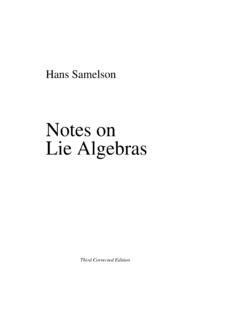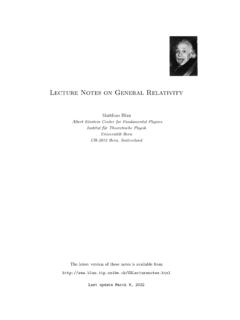Transcription of A Child’s Guide to Spinors - weylmann.com - Hermann Weyl
1 A child s Guide to SpinorsWilliam O. StraubPasadena, California 91104 December 31, 2016No one fully understands Spinors . Their algebra is formally understood, but their geometrical significance is some sense they describe the square root of geometry and, just as understanding the concept ofp 1took centuries,the same might be true of Spinors . Sir Michael Atiyah, British mathematicianThe fermionic particles that make up all ordinary matter in the universe are described not by scalars, vectors ortensors, but by mathematical quantities known asspinors. Scalars and vectors are taught in high school, and tensorsnormally get introduced in undergraduate school, but spinor formalism is generally postponed until graduateschool. The reason seems to be that Spinors , which fully incorporate special relativity including the Lorentzgroup of rotations and boosts are deemed more complicated than other, more familiar mathematical objectsdespite their apparent greater simplicity.
2 When students ask what exactly is a spinor, they invariably hear that it ssomething like the square root of a vector, a two-component vector-like object that has special transformationproperties. When the student then looks to the available literature, she finds detailed information presented onlyin quantum field theory or abstract mathematical descriptions that defy comprehension to the we derive the spinor formalism at a very elementary level, intended as an introduction for the typical un-dergraduate student who wants to pursue directly related subjects, especially the Dirac relativistic electron I Hate SpinorsI recall the time, many years ago, when I was first introduced to the Dirac relativistic electron equation,i h (x,t)=mc (x,t)(1)Profound, intuitive, easy to derive, and expressed in beautiful covariant notation, it all made perfect sense to me.
3 The partial derivative is a covariant vector, the 4 4 Dirac gamma matrices obviously represent acontravariant vector, and the wave function (x,t)is a scalar (even though it has four components, like a4-vector). No, said the professor, although the derivative is indeed a vector, is not, so Lorentz invariance of theequation depends on how the wave function (which is also not a scalar) transforms. He then added, The wavefunction is a complex, multi-component vector-like quantity that has special transformation properties. The professordid not the course went on, I noted that the gamma matrices were invariably treated as though they constituted a truevector they could be expressed as either or , as the index could be raised or lowered by the metric tensorg org , and the matrices could also be transformed into flat-space Lorentz form using tetrads ( a=ea ).
4 Furthermore, I learned that the metric tensor itself is composed of the gamma matrices viag =12( + )All this meant that the must also be functions of the coordinates, which led me to think that really is a scalarafter all, and that the Dirac equation must also be valid in curved professor went on to sketch the solution of the Dirac equation for the hydrogen atom (which I found wasconsiderably more difficult than solving the non-relativistic Schr dinger equation). In all that time, the professornever mentioned the word spinor. When I discovered that I was wrong about everything, I quickly learned to hate Spinors . They re non-intuitive, farmore complicated than they have any right to be, and come either with two components or four (like the Diracspinor, which is actually a stack of two Spinors called abispinor), both versions being equally hard to come to you innocently disguised as either scalars or vectors, but they do not act like scalars or vectors at all,especially when you try to calculate their inner and outer products.
5 Since they involve complex variables, spinorsare most comfortable in the world of quantum mechanics, although they can be dragged kicking and screaminginto general relativity, where they cause all kinds of trouble. They figure prominantly in the preposterouslycomplicated theory known assupersymmetry, where they wear all manner of bewildering notational disguisesinvolving subscripts, superscripts, daggers, hats, dots, tildes, squiggles and overbars, and even then the notationusually comes up were originally introduced by the French mathematician lie Cartan in 1913 (and subsequently greatlyexpanded upon by Hermann weyl , Richard Brauer and Oswald Veblen). Unfortunately, Cartan s bookThe Theoryof Spinorsis quite formal and of little use to the undergraduate (I still find it incomprehensible). But Spinors werelater found to be absolutely indispensible in describing the behavior offermions, particles that make up all thecommon stuff you re familiar with electrons, protons, neutrons and the believe that the Creator didn t have a sense of humor when she invented something as damnable as spinorsto describe all the ordinary matter in the universe, including IntroductionAgain, fermions like protons, electrons and quarks comprise all the ordinary matter in the universe.
6 But despitethis nearly universal dominance in Nature, they do not obey the behavior typical of scalar, vector and tensorquantities, but that of Spinors . So what is a spinor? It s essentially a two-component vector-like quantity in whichrotations and Lorentz boosts are built into the overall formalism. In that simplistic sense, a spinor is not the square root of a vector, but much more like half of a 4-vector. The fact that they exist at all is remarkable, and ifthey were of only mathematical interest they might easily be notion of electron spin was first surmised in 1922 when the German physicists Otto Stern and WaltherGerlach noticed that a stream of silver atoms (each having a single electron in the outer 5s orbital) could beseparated by a non-uniform magnetic field into two streams, up and down. At the time, no one knew what tomake of this odd behavior, but three years later George Uhlenbeck and Samuel Goudsmit proposed that electronscould exist in two spin states, 1/2, each with the units of angular momentum h=h/2.
7 Still, the concept ofelectron spin varied between a simplistic physical spinning of the electron about some axis (like a child s top)and a kind of internal angular momentum. Today we look upon electrons and other spin-1/2 particles as havingan intrinsic angular momentum with no classical counterpart. This gave rise to the notion of such particles livingin spin space, an abstract two-dimensional internal space that requires a description beyond that of scalars,vectors and tensors. Cartan s spinor formalism was found to be appropriate for this attempts have been made over the years to explain Spinors at an intuitive, elementary level, but the simplestapproach remains an appeal to basic Lorentz group theory. This is rather a pity, because undergraduate studentsoften express an aversion to group theory because of its mathematical nature. But the theory of Lorentz rotationsand boosts is relatively simple, and it has the nice property of being relativistic from the start.
8 In addition, it neatlyadmits a formalism that underlies that of the 4-vectors it ordinarily applies to, which is where Spinors come better, Lorentz theory confirms the intuitive notion that if a spinor represents half of a 4-vector (rather thanthe square root), then there should be two kinds of spinor: one comprising the upper half and anotherrepresenting the lower half. This observation is critical, since a single two-component spinor can be shown toviolate odd-even parity in quantum physics, and it takes two Spinors acting together to preserve it. Thus, the Diracbispinor a four-component object consisting of two stacked Spinors fully preserves approach will therefore be based on the Lorentz transformations of rotations and boosts. There are, however,a few subtleties that other, more advanced treatments either gloss over or assert by inference, and I will try toexplain these in a more straightforward and understandable manner as we go Getting StartedMany physics professors, when questioned about the nature of Spinors , will simply respond with They retwo-component, vector-like quantities with special transformation properties.
9 The key word here is2transformation. A transformation is something like a change in appearance that somehow doesn t affect anyunderlying physics. But how on Earth can a simple quantity like = 10 (which is a spinor) possibly transform? To answer this, we resort to the standard formalism of vectortransformations: we find ourselves a square matrix that takes a vector and turns it into another vector that sequivalent in some sense. Some care needs to be exercised here a transformation might take a vector andphysically turn it in a new direction (in which case it s a different vector), or it might just express the same vectorin some other, possibly more convenient, coordinate system. It s mainly this latter case we ll be concerned 3- and 4-vectors typically get transformed by matrices with real components. Such matrices reflect thereal aspects of the vectors they transform, so we typically see 3 3 and 4 4 matrices that are themselvessymmetric, antisymmetric, or orthogonal, with real components.
10 But for mathematical reasons 2 2 matrices inphysics need to beunitary, meaning that their conjugate tranposes are equal to their inverses, orU =U , unitary matrices are in general not real butcomplex, and they act on vectors that are also complex. Italso means that the Spinors they transform will have complex character. So, while 2 2 matrices and spinorsmight appear to be simpler than4 4 matrices and 4-vectors, this simplicity is largely illusory, and that s probablywhat makes Spinors so hard to , it s not difficult to build the most general2 2 matrix possible, which I exhibit here without proof. Ifaandbare any two complex variables, then the matrixU= a b b a ( )is unitary, subject to the condition thataa +bb =1. Thus there are4 1 independent real variables inU, whichwill turn out to be very convenient. A related quantity we ll need later is the conjugate transpose ofU, designatedasU , which also happens to be the inverse matrixU 1.








